SISCO car fault coder reader compatible with most OBD II vehicles in the U.S. since 1996, this car code reader supports nine standard protocols of OBDI/EOBD. Plug and play, can quickly read the car's fault infomation and vehicle parameters, is a more comprehensive function of the fault diagnosis instrment.

A Large Screen with User-Friendly Interface
- Clear LCD Display: The OBD2 car code reader features a high-definition color screen, making it easy to navigate through different options and read codes.
- OBD-II Functionality: Allows access to the OBD-II diagnostic system, enabling users to read and clear engine trouble codes (DTCs).
- Battery Check: Includes a battery test function, the car diagnostic code reader providing quick checks on the vehicle's battery status to prevent unexpected issues.
- User-Friendly Interface: The interface is simple with four primary buttons: OBD II, Battery, DTC Lookup, and Set Up, for easy navigation through various diagnostic functions.

Engine System Scan, Data Can be Read in Real Time
- Full Engine System Scan: Accurately scans the engine control module (ECM) to detect issues related to ignition, fuel system, emissions, and more.
- Live Data Stream: The auto fault code reader displays real-time sensor data such as engine RPM, coolant temperature, fuel trim, O2 sensor readings, and more for accurate diagnostics.
- Graphical Data Display: SISCO car engine code reader supports real-time data graphing for easier trend analysis and problem identification.
- Freeze Frame Data: Retrieves and displays snapshot data stored when a trouble code is set to help identify the cause of the fault.
- Quick Trouble Code Reading & Clearing: Easily reads and clears diagnostic trouble codes (DTCs) to reset the Check Engine Light.
Application
SISCO automotive code reader apps are primarily used in the automotive repair industry to help technicians diagnose issues in systems like engines and transmissions. These tools are also widely used in fleet management, vehicle manufacturing, insurance, emissions testing, and automotive education. They not only enhance repair efficiency and reduce repair costs but also provide consumers and fleet managers with real-time vehicle health monitoring, helping to extend vehicle lifespan and optimize operational costs.

Car Repair and Maintenance

Insurance Industry

Emissions Testing

Vehicle Manufacturing
| Model | SISCO-CR-V315 |
| Operating Voltage | 9-16V |
| Operating Current | 48-72mA |
| Operating Environment | -40-70°C |
| Storage Temperature | -40-70°C |
| Supports Languages | English, German, French, Spanish, Italian, Russian, Dutch, Chinese, Japanese, and Korean |
| Dimensions | 180*120*43mm |
| Weight | 300g |
| Engine Fault Diagnosis | √ |
| Engine MIL-Q Light Clearing | √ |
| Freeze Frame | √ |
| I/M Ready Status | √ |
| Vehicle Information Reading | √ |
| Real-Time Data Streaming | √ |
| Vehicle Battery Voltage Reading | √ |
| Real-Time Graphs | √ |
| Oxygen Sensor Test | √ |
| Mode 8 (EVAP) Test | √ |
| DTC Query | √ |
Q1: What is a code reader?
A1: A code reader is a device used to quickly retrieve and display data encoded in specific formats. In the automotive field, it typically refers to a tool that connects to a vehicle's OBD-II port to read diagnostic trouble codes, helping identify issues related to the engine or emissions system. In retail or logistics, a code reader may refer to a scanner that reads barcodes and QR codes for inventory, checkout, or tracking purposes.
Q2: Does a car have to be running to use a code reader?
A2: No, a car does not have to be running to use a code reader, but the ignition usually needs to be in the "ON" position (engine off, but electronics on). This powers the vehicle's onboard computer system, allowing the code reader to communicate with it and retrieve diagnostic trouble codes. Some functions, however—like real-time data—may require the engine to be running.
Q3: What's the difference between a code reader and a scan tool?
A3: A code reader and a scan tool are both used to diagnose issues in vehicles, but they differ in functionality:
- A code reader is a basic device that reads and clears diagnostic trouble codes (DTCs) and may turn off the check engine light. It's useful for simple diagnostics.
- A scan tool is more advanced. In addition to reading and clearing codes, it can show live sensor data, run system tests, access vehicle information, and sometimes even program modules.
In short, all code readers are scan tools, but not all scan tools are basic code readers-scan tools offer much more detailed and professional-level diagnostics.
Tips: What kind of data can I read with automotive diagnostic code reader?
An automotive diagnostic code reader allows you to access important data from your car's onboard computer. It can display trouble codes (DTCs) that point to issues with the engine, transmission, or emissions system. It also reads real-time data such as engine RPM, temperature, fuel status, and more. Additionally, it can show freeze frame data (a snapshot when an error occurs) and help check if your vehicle is ready for emissions or smog tests.
Thank you for buying industrial test and measurement equipment on SISCO.com, all products sold by SISCO and the partner cover a 12 months warranty, effective from the date of receiving the products.
What is covered?
SISCO is responsible for providing free spare parts, and free technical support to assist the customer to repair the defective products until the problem is solved.
What is not covered?
- Product purchased from anyone other than a SISCO store or a SISCO authorized reseller.
- Expendable parts.
- Routine cleaning or normal cosmetic and mechanical wear.
- Damage from misuse, abuse or neglect.
- Damage from use of parts other than SISCO approved.
- Damage from use outside the product’s usage or storage parameters.
- Damage from use of parts not sold by SISCO.
- Damage from modification or incorporation into other products.
- Damage from repair or replacement of warranted parts by a service provider other than a SISCO authorized service provider.
- Damage caused by the application environment not meeting the product usage requirements and the failure to perform preventive maintenance.

